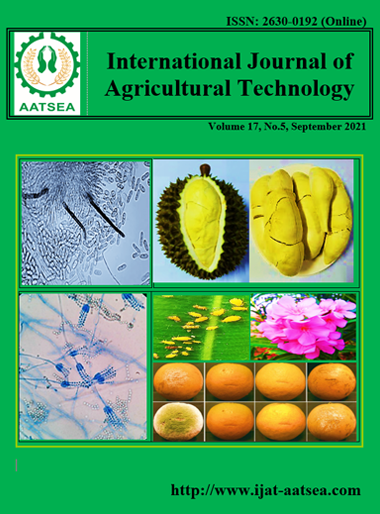Disease incidence and molecular diversity of Tungro Virus on Rice (Oryza sativa) in Bengkulu, Indonesia
Main Article Content
Abstract
There has been no updating data on the incidence of viral diseases that attack rice plants in Bengkulu. Updating data on viral disease distribution status is an initial step to prevent disease outbreaks. The disease incidence and molecular characterization of the tungro virus in Bengkulu, Indonesia wasc reported. Detection of viruses from field samples was amplified Rice Tungro Spherical Virus (RTSV) and could not be amplified RTSV from other field samples. Specific DNA fragments of ±787 bp were successfully amplified using specific primers for the coat protein gene of RTSV. Spesific DNA fragments of 1400 bp were succesfully amplified from Rejang Lebong, Bengkulu Tengah, Bengkulu Utara, and Bengkulu city using Rice Tungro Bacciliform Virus (RTBV) spesifics primers DAF and DAR. The results showed that the RTBV rice isolates from Bengkulu Utara and Rejang Lebong were closely related to the RTBV Seberang Perai isolates from Malaysia (MK552377)
Article Details

This work is licensed under a Creative Commons Attribution-NonCommercial-NoDerivatives 4.0 International License.
References
Azzam, O., Arboleda, M., Umadhay, K. M. L., De los Reyes, J. B., Cruz, F. S., Mackenzie, A. and McNally, K. L. (2000). Genetic composition and complexity of virus populations at tungro-endemic and outbreak rice sites. Archives of Virology, 145:2643-57.
Azzam, O. and Chancellor, T. C. B. (2002). The biology, epidemiology, and management of rice tungro disease in Asia. Plant Disease, 86:88-100.
Cabauatan, P. Q., Melcher, U., Ishikawa, K., Omura, T. and Hibino, H. (1999). Sequence changes in six variants of rice tungro bacilliform virus and their phylogenetic relationships. Journal of general virology, 80: DOI:10.1099/0022-1317-80-8-2229.
Chancellor, T. C. B., Holt, J., Villareal, S., Tiongco, E. R. and Venn, J. (2006). Spread of Plant Virus Disease to New Plantings: A Case Study of Rice Tungro Disease. Advances in Virus Research, 66:1-29.
Doyle, J. J. and Doyle, J. L. (1990). Isolation of plant DNA from fresh tissue. Focus, 12:13-15.
Fabre, P., Hautier, L., Dimitrov, D. and Douzery, E. J. P. (2012). A glimpse on the pattern of rodent diversification : a phylogenetic approach. BMC Evolutionary Biology, 12:88.
Fan, Z., Dahal, G., Druka, A., Burns, T. M., Villegas, L. C., Fan, Z., Shrestha, R. B. and Hull, R. (1996). Some biological and genomic properties of rice tungro bacilliform badnavirus and rice tungro spherical waikavirus from Nepal. Annals of Applied Biology, 129:267-287.
Hibino, H. (1996). Biology and epidemiology of rice viruses. Annual Review of Phytopathology, doi:10.1146/annurev.phyto.34.1.249.
Hull, R. (1996). Molecular biology of rice tungro viruses. Annual Review of Phytopathology, doi:10.1146/annurev.phyto.34.1.275.
Janzac, B., Fabre, F., Palloix, A. and Moury, B. (2009). Constraints on evolution of virus avirulence factors predict the durability of corresponding plant resistances. Molecular Plant Pathology, 10:599-610.
Muliadi, A. and Widiarta, I. N. (2017). Improvementnof resistance to tungro disease on rice variety. Iptek Tanaman Pangan, 12:91-96.
Nath, N., Mathur, S. and Dasgupta, I. (2002). Molecular analysis of two complete rice tungro bacilliform virus genomic sequences from India. Archives of Virology, 147:1173-1187.
Praptana, R., Sumardiyono, Y. B., Hartono, S. and Trisyono, Y. A. (2017). Variasi Genetik Rice Tungro Bacilliform Virus ( RTBV ) dari Daerah Istimewa Yogyakarta , Nusa Tenggara Barat , dan Sulawesi Tengah. Jurnal AgroBiogen, 13:75-82.
Sharma, S. and Dasgupta, I. (2012). Development of SYBR Green I based real-time PCR assays for quantitative detection of Rice tungro bacilliform virus and Rice tungro spherical virus. Journal of Virological Methods, 181:86-92.
Sharma, S., Rabindran, R., Robin, S. and Dasgupta, I. (2011). Analysis of the complete DNA sequence of rice tungro bacilliform virus from Southern India indicates it to be a product of recombination. Arach Virol, 156:2257-2262.
Skelsey, P., Rossing, W. A. H., Kessel, G. J. T., Powell, J. and Werf W Van Der. (2004). Influence of Host Diversity on Development of Epidemics : An Evaluation and Elaboration of Mixture Theory, Phytopathology, 95:328-338.
Tamura, K., Stecher, G., Peterson, D., Filipski, A. and Kumar, S. (2013). Mega6: Molecular evolutionary genetics anaysis version 6.0. Mol. Biol. Evol. 30:2725-2729.
Tiwari, A. K., Snehi, S. K., Singh, R., Raj, S. K., Rao, G. P., Sharma, P. K., Kunraghat, S., Molecular, P. and Marg, R. P. (2012). Molecular identification and genetic diversity among six Begomovirus isolates affecting cultivation of cucurbitaceous crops in Uttar Pradesh, India. Archives Of Phytopathology And Plant Protection, 45:62-72. doi:10.1080/03235400903458803.
Villegas, L. C., Druka, A., Bajet, N. B. and Hull, R. (1997). Genetic Variation of Rice Tungro Bacilliform Virus in the Philippines. Virus Genes, 15:195-201.


